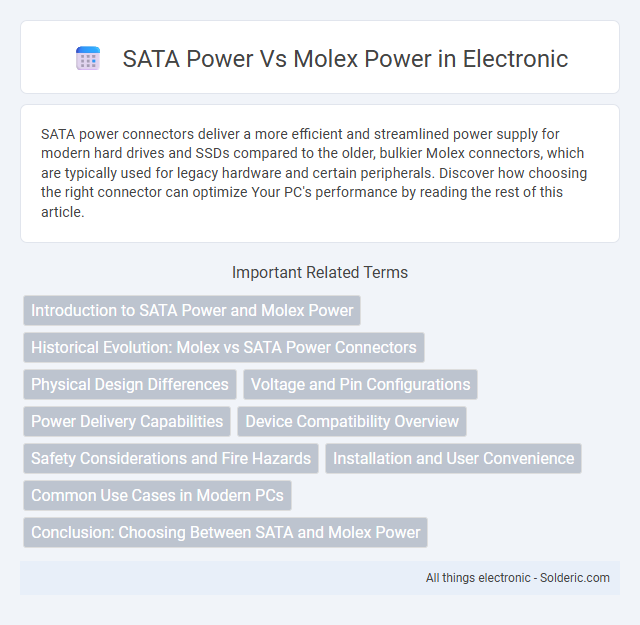SATA power connectors deliver a more efficient and streamlined power supply for modern hard drives and SSDs compared to the older, bulkier Molex connectors, which are typically used for legacy hardware and certain peripherals. Discover how choosing the right connector can optimize Your PC's performance by reading the rest of this article.
Comparison Table
| Feature | SATA Power Connector | Molex Power Connector |
|---|---|---|
| Connector Type | 15-pin flat connector | 4-pin rectangular connector |
| Voltage Rails | 3.3V, 5V, 12V | 5V, 12V only |
| Current Capacity | Up to 54W total | Up to 72W total |
| Device Compatibility | Modern HDDs, SSDs, optical drives | Older HDDs, optical drives, some fans |
| Data Transfer | Power only, separate SATA for data | Power only, separate IDE for data |
| Installation | Hot-swappable, keyed connectors | Non-keyed, more prone to incorrect connection |
| Common Usage | Modern desktops, laptops | Legacy systems, older hardware |
| Wire Gauge | 18 AWG typically | 16 or 18 AWG |
Introduction to SATA Power and Molex Power
SATA power connectors deliver 3.3V, 5V, and 12V rails with a 15-pin design, supporting modern storage devices like SSDs and HDDs with enhanced power efficiency and hot-swapping capabilities. Molex power connectors, featuring a 4-pin design, provide primarily 5V and 12V outputs, commonly used in legacy hardware and peripherals such as older hard drives, optical drives, and fans. The transition from Molex to SATA power reflects advancements in power delivery standards tailored for newer device requirements and improved cable management.
Historical Evolution: Molex vs SATA Power Connectors
Molex power connectors, introduced in the 1980s, were the primary standard for powering computer components like hard drives and optical drives before the widespread adoption of SATA devices. SATA power connectors, developed in the early 2000s alongside the SATA interface, offer improved pin configuration and power delivery, supporting advanced features such as hot-swapping and staggered spin-up. Understanding the historical evolution from Molex to SATA power connectors can help you optimize your PC build for compatibility and future-proofing.
Physical Design Differences
SATA power connectors feature a flat, slim 15-pin design with a distinct L-shaped key, ensuring proper alignment and preventing incorrect insertion in modern hard drives and SSDs. Molex power connectors have a bulkier, rectangular shape with four larger pins, typically used in older hardware like IDE drives and some peripherals. Your choice between SATA and Molex power connectors depends on device compatibility and physical space constraints inside your PC case.
Voltage and Pin Configurations
SATA power connectors provide 15 pins divided into three voltage rails: 3.3V, 5V, and 12V, which supports modern hard drives and SSDs with separate power lines for efficiency. Molex power connectors have only 4 pins, supplying 5V and 12V voltages without dedicated 3.3V power, making them suitable for older devices but less versatile for newer hardware. The 15-pin SATA power connector features a slim and flexible design, while the bulkier 4-pin Molex lacks the ability to deliver multiple voltage levels simultaneously.
Power Delivery Capabilities
SATA power connectors deliver 3.3V, 5V, and 12V with a maximum current of approximately 1.5A per pin, supporting modern hard drives and SSDs efficiently. Molex connectors provide primarily 5V and 12V lines, capable of higher current loads, often up to 11A on 12V pins, making them suitable for older hardware and peripherals requiring more substantial power. SATA's integrated voltage sense pins enhance power delivery management, whereas Molex connectors rely on simpler, direct voltage lines without signal detection capabilities.
Device Compatibility Overview
SATA power connectors are primarily designed for modern storage devices such as SSDs, HDDs, and optical drives, featuring a 15-pin configuration that supports advanced power management and higher current delivery. Molex power connectors, with their 4-pin design, are mainly used for legacy devices like older hard drives, fans, and some peripherals, offering simpler and lower power output. Compatibility depends on the device's power input requirements, with SATA power connectors being the standard for current hardware due to their enhanced features and scalability.
Safety Considerations and Fire Hazards
SATA power connectors feature built-in safeguards such as hot-plug support and improved pin design that reduce the risk of electrical shorts and overheating compared to Molex connectors, which have a higher likelihood of loose connections and exposed pins that can spark. Molex connectors are prone to poor contact under high current loads, increasing the chance of arcing and fire hazards in older or improperly maintained systems. Ensuring your system uses SATA power connectors with quality cabling significantly enhances electrical safety and minimizes fire risk.
Installation and User Convenience
SATA power connectors offer a more streamlined and user-friendly installation compared to Molex connectors, featuring a slimmer design and keyed connectors that prevent incorrect orientation. Molex connectors, being larger and less intuitive, require more effort to connect securely and often need additional adapters for modern devices. Your setup will benefit from SATA power's ease of use, especially in tight spaces and for efficient cable management.
Common Use Cases in Modern PCs
SATA power connectors are primarily used to supply power to modern storage devices such as SSDs and HDDs, ensuring efficient data transfer and reliable performance in contemporary PCs. Molex power connectors, once widespread for older peripherals like IDE drives, fans, and lighting, are now mostly reserved for legacy hardware or specialized components requiring higher voltage demands. The shift to SATA power connectors aligns with advancements in motherboard designs emphasizing compact and streamlined power delivery systems for modern computer builds.
Conclusion: Choosing Between SATA and Molex Power
Choosing between SATA and Molex power connectors depends on your device compatibility and power requirements. SATA power connectors provide a slimmer design and support advanced features like 3.3V rails, suitable for modern hard drives and SSDs. Molex connectors remain useful for legacy devices and peripherals requiring 5V or 12V power, but your build will benefit most from SATA connectors for efficient, standardized power delivery.
SATA power vs Molex power Infographic

 solderic.com
solderic.com